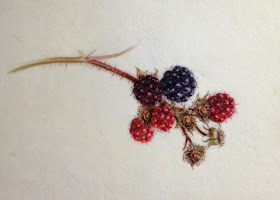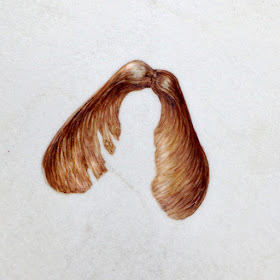Haven't written a blog post for over almost a month and it's really bothering me! There's one in the offing about photographing artwork but it requires some use of the grey matter to finish it off, so here's s something about the new 30 Day Challenge in the meantime. It was initiated on the Botanical Artist's Facebook Group, and requires 30 small works to be completed during September. Over the past few years I've tried a few of these Challenges,
here's a link to one that I actually completed in 2013, and wrote a daily blog for.
This time I wanted to try something different so have decided to do all 30 on vellum....it is do-able
if I keep it simple!
 |
| Day 5-10 Violas on Kelmscott Vellum, size approx 8 x 6. I bought these
little pots of flowers from the local DIY store and painted the whole
sheet in one day because I was so behind. The palette included: Holbein
Manganese Blue PB33 ( not the hue) with W & N Cobalt Violet and
Quin Magenta. I love the way PB33 separates, it's really useful for high
light value pale violet flowers, with both pink and blue present. Also
Violet Dioxazine. Lemon Yellow NT and Cadmium Yellow for the flower
centres. The greens included Cobalt Violet, Lemon Yellow and permanent
rose. |
The Challenge started while I was away in Italy, where I visited the Venice Biennale, it's good to view a diverse range of art and the Biennale was certainly that! diversity definitely feeds the brain and upon my return I was was left playing 'catch-up' with the Challenge but definitely inspired to work.
I try to tie in this sort of challenge with other work, and these little studies are prefect for video examples for my new online Vellum Course which is underway with 5 great new students. Currently I'm also working on a large vellum painting of Roses on vellum so no doubt a few roses will probably feature here and there. Here's a little bud of Olivia Rose Austin, which was my 4th painting.
 |
| No 4. Olivia Rose Austin Bud. 5 x 3 inches on Kelmscott. Colours: Permanent Rose and Lemon Yellow n.t. for the pink with Cobalt Violet for the cool pink shades. A small amount of Permanent Carmine was also used to deepen the colour . The green mix is Cobalt Blue, Transparent Yellow and Permanent Rose. The stem Perm rose, Trans Yellow and Brown Madder |
The Blackberry studies are good as preparatory works for another painting, which is for a competition, the final piece will be on a piece of mounted natural vellum though. This is more challenging than the Kelmscott but this piece is all good practice with the subject.
 |
| Day 1. Blackberry Study on Kelmscott, approx 7 x 5.5 inches. Love painting blackberries and working with dark colours. The black mix is Indanthrene Blue, Permanent Carmine and a very small amount of Trans Yellow. The bias of the mix is on the violet side. Where the fruit is more of a dark red colour, the quantity of Permanent Carmine is increased. The red is Perm Carmine and Scarlet lake for the warmer red. Stems and all other parts are mixed from the same 4 colours. There is really mo need for lots of colours when a few will do and the use of the same colours created better harmony in a painting. |
 |
| No. 3 This is a simple study of a single fruit and leaf but painted with Ivory Black. This is a very thick piece of vellum 6 x 2 inches. I quite like this effect and have been playing with it recently. It's all about getting the tone right before working with colour. It's also an approach that I teach as good practice in preparatory work. |
Also completed on the first day was a simple single maple seed, not particularly well painted but very quickly completed. I used the earth colours for this, it was a pretty lazy effort. In the 2013 Challenge a maple seed was the first subject and it seemed a good idea to repeat on vellum.
 |
| Maple seed on Kelmscott, 3 x 2.7 inches. I used some Manganese Blue on the shine. Thereafter Raw Umber wash, followed by building texture with Brown Madder and Van Dyke Brown, a small amount of Ultramarine Violet was added for the shadows. Lots of sweeping and drawing dry brush work here. |
I've almost caught up! Maybe I'll even manage all 30. Ive plenty of vellum off - cuts so no excuses.
The Photographing artwork post will hopefully follow shortly.























